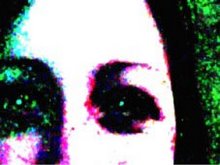Wednesday, March 24, 2010
Stick it y'all!!!
While you're around the city you may also like to check out Mangamorphosis, but hurry because it closes Saturday.
Collage through the times
Collage
1 a : an artistic composition made of various materials (as paper, cloth, or wood) glued on a surface b : a creative work that resembles such a composition in incorporating various materials or elements
2 : the art of making collages
(http://www.merriam-webster.com/dictionary/collage)
 Raoul Hausman 'The Art Critic' 1919-1920
Raoul Hausman 'The Art Critic' 1919-1920
A thoroughly modern medium, collage expressed the characteristics of the 20th Century - immediacy, the mass media and capitalism - through creative process and concept. Collage, coming from the French term coller, meaning glue, paste or stick, is the construction of pictures through the pasting of torn images.
John Heartfield 'Adolf the Superman: Swallows Gold and Sprouts Junk' 1932
According to the International Museum of Collage, Assemblage and Construction, collage as an artform is much more than just simply making pictures. "It's a mode of perception, a multi-dimensional language with aesthetic implications that spans the histories of art, architecture, literature and music."
Kurt Schwitters 'The Proposal' 1942
Collage first emerged as a fine art medium in the form of papier colles, or pasted papers, from Cubists Georges Braque and Pablo Picasso. Since, it has been an important medium throughout Modern art, showing up in Italian Futurism, Constructivism, Dada, Surrealism, Pop Art and Fluxus. Artists who worked in the collage medium included Kurt Schwitters, Max Ernst, Marcel Duchamp and Joseph Cornell; who asserted that art could be made from anything. Abtract Expressionsist artists, such as Robert Motherwell, were attracted to the medium to expand their practice in abstract painting (IMCSC 2005).
 David Hockney 'Pearblossom Hwy, 11th-18th April, 1986, #2' 1986
David Hockney 'Pearblossom Hwy, 11th-18th April, 1986, #2' 1986
Contemporary artists use collage, and the closely related assemblage and mixed media, to construct a visual representation of their world and experiences, by using found objects and objects closely bound to the everyday; which viewers make an immediate identification to.
Peter Lewis 'The Birth of the Information Age' no date
Peter Lewis 'Tiki Touring' no date
As a medium, collage blurs the boundaries or bridges the dichotomy between high and low art or pop art; text and image; figuration and abstraction; past and present; and two and three dimensions (ibid). According to media theorist Marshall McLuhan. collage effectively breaks down perspectivalism, while at the same time emphasises the disparity of images or objects it juxtaposes.
Martin Smith 'Teevee #13' 1999
A collage is not just a bunch of random things pasted together. It is important to consider conventional design elements and principles such as composition, line, shape, colour, form, texture, etc; and what the images and objects in the collage represent and the meaning they add to the work. So before cutting and pasting, have a clear understanding of the message you want to send to your audience and the theoretical and conceptual underpinnings of the work.
Traditional collage and practice and digital collage practice share the same characteristics, both immediate and seemingly simple, yet potentially tedious and complex.
Natsuki Kimura 'Gone' 2000
Further Reading:
Greenberg, Clement. "Collage (The Pasted Paper Revolution)." Art News 57.5 (September 1958): 46-49, ff.
Rosenberg, Harold. "Collage: Philosophy of Put-Togethers." Art on the Edge. New York: Macmillan, 1975.
Barthes, Roland. "The Rhetoric of the Image." Image-Music-Text. Trans. Stephen Heath. New York: Hill and Wang, 1977.
Waldman, Diane. Collage, Assemblage and the Found Object. New York: Harry N. Abrams, 1992.
Wescher, Herta. Collage. Trans Robert E. Wolf. New York: Harry N. Abrams, 1968.
Online resources for digital collage artists:Ear Studio
Jonathon Baker
Natsuki Kimura
Tuesday, March 16, 2010
Photography Terms
ART PROPOSAL DUE SOON
To help you in writing your proposal you may like to check out the Artists Foundation Resources for Artists, in particular How to write a proposal.
Genres and Contemporary Artists of Art Photography
Monday, March 15, 2010
WEEK 4 - Vision and Manipulation
Sunday, March 14, 2010
Captain Amerika!
Wednesday, March 10, 2010
WEEK 3 - txt, pix & mre: Mobile Phone Art
Mobilising Phone Art
CELL PHONE: Art and the Mobile Phone
Portable Worlds
Future Screen Mobile
Dialtones (A Telesymphony)
Sleepy Urbanite
Some ideas for mobile phone art you may want to explore:
Poetry
Haiku (Japanese poetry)
SMS
MMS
Flash SMS/MMS
Video art
Short film
ASCII art
Collaborative piece
Game
GPS
Music
Ringtone
Sound
Light
Photography
The spoken word
And themes or issues you might want to address may include:
Privacy
Language
Space
Surveillance
Communication
Technology
Globalisation
Community
You may want to create the artwork on your phone or on the computer (i.e. in Illustrator) and then bluetooth it to your phone. You may want to create send the artwork to all of your peers, display it on your phone, use your phone as a part of a sculpture... there are so, so many possibilities! GO WILD!!!
LTR HDS @ 1000 pound bend
Saturday, March 6, 2010
MORE TEXT ART LINKS
WEEK 2 - THE TEXT EFFECT
The Written Word - approaches to creative use of text
Tuesday, March 2, 2010
Facebook groups you may like to join
Australian Contemporary Artist Network
unMagazine
Art World
Centre for Contemporary Photography
National Gallery of Victoria
Seventh Gallery
Footscray Community Art Centre
Bus Projects
Melbourne Fringe
Art News
emaj
Artshub
Artabase
Welcome to Intro to Digital Art at Victoria University
This blog has been set up as an important resource tool for you guys to refer to through out this semester. I will be posting websites of interest, articles, images and notes and reminders for class. So it is important that you refer to this website regularly!
I will also provide links to everyone's digital art journal (both Monday and Wednesday classes), so you can interact with your fellow students, provide feedback, share links etc.
Occasionally, I may start a discussion topic, and would appreciate your contribution.
Happy blogging!
:) Jenna






